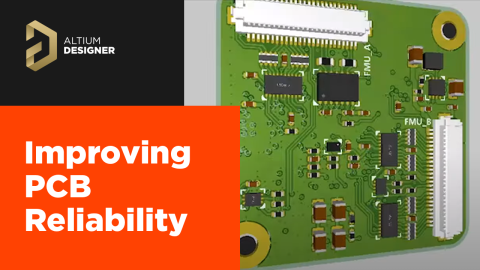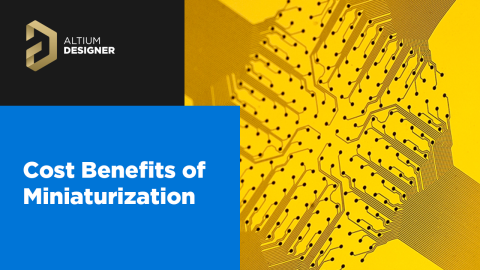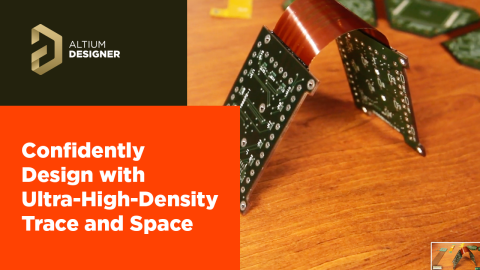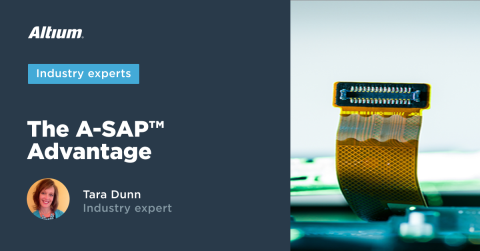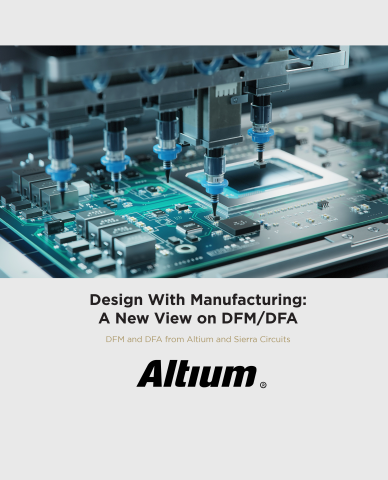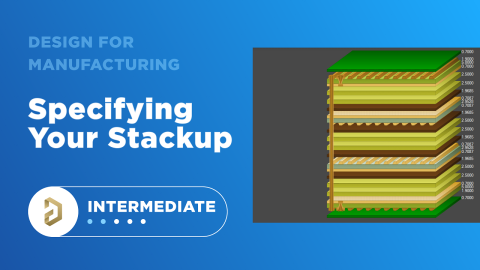Design to Manufacturing with a Single Mouse Click

Imagine if you could design your circuit board, run simulations, source your parts, generate an accurate BOM, generate your output files and simply press a “send to manufacturing” button all within your design environment? While that may sound like a far-off dream, this interview with Misha Govshteyn from MacroFab will give you insight into how they are partnering with Altium to make this dream a reality very soon.
Judy Warner:
Misha, please share a brief overview of what MacroFab does and how you have developed software solutions to improve the way electronics professionals engage with and source electronic manufacturing services (EMS)?
Misha Govshteyn:
MacroFab is a digital manufacturing platform for electronics assembly, essentially enabling engineers to produce new designs faster and helping enterprises bring their products to market by scaling - from NPI stages to production - in low-cost manufacturing regions. Our service provides access to specialized factories all across North America, allowing customers to seamlessly scale through every stage of production. The company was founded by two robotics engineers who wanted to build a manufacturing service that offered a cloud service experience, similar to AWS and Azure.
For electronics engineers, MacroFab provides a turnkey PCB assembly service, driven by software and modern APIs. Engineers can get price guidance for their designs at any volume, access to real-time materials availability and pricing data, and place orders online through a self-service interface or by pre-approved company Purchase Orders. All manufacturing data is online, allowing engineers to track changes to their boards over time and assure the integrity of their design as it moves to the supply chain team for production.
For supply chain teams, MacroFab provides a simple platform for sourcing production-level electronics assembly services from 70+ factories in the US, Canada, and Mexico, which lowers overhead costs and assures each job is matched with the right factory providing the best price, quality, and lead time. The MacroFab platform is used by supply chain teams to build everything from PCB assemblies to fully assembled and tested electronics products. Enterprises rely on MacroFab to either move production from their existing US-based electronics contract manufacturers to consolidate vendors or to re-shore/near-shore production from China to the US/Mexico.
Warner:
Please describe some of the prevailing problems you are working to remedy, and how you’re using software to improve the hardware development process?
Govshteyn:
MacroFab is fundamentally a distributed, software-enabled factory. In traditional manufacturing, the paradigm is outsourcing - you contract with a factory to produce products for you - but what happens if that single factory encounters problems? That means problems for the customer, too. With MacroFab, however, our customers use us as a service built on cloud principles, and we work very differently as a result.
First, we start with native design files from EDA tools and in many cases work closely with EDA software providers to understand their formats. This allows us to build a single source of truth for manufacturing, down to the Bill of Materials and assembly instructions. MacroFab software orchestrates the production process, and it happens the same way no matter which factory builds the product.
Second, we are the control plane for all manufacturing operations. This means that MacroFab sources the materials, MacroFab assembles them into production kits for delivery onto the factory floor, and MacroFab is ultimately responsible for the quality of the product. In fact, in many cases, MacroFab will go through the NPI process, design custom test fixtures, and dropship them to the factory as part of the execution of every job.
Third, MacroFab has built a distributed network of factories all across North America. Some of these are specialty factories producing low-volume products, some are very large high-volume factories in Mexico producing hundreds of thousands of units. This allows us to scale in a way only Tier 1 manufacturers can scale, but we can move much faster. Some of our customers take this to the max - with multiple factories building their products in parallel, maximizing output and growth.
Finally, our software is built on cloud design patterns. This means that we design for failure and assume that anything can go wrong, and will. It also means that everything we do is based on a custom software stack, designed from the ground up to make manufacturing work the way we think it should work. In practical terms, this means we can do things other manufacturers cannot. We can source ahead of demand, and store inventory for our customers, which includes finished goods. We can drop ship assembled, tested, and packaged products directly to their end-users.
We can also find ways to re-engineer around supply chain limitations. A lot of our customers have found that once the materials are sourced, we can build their products anywhere in North America. The horror stories you hear about container ships idling in ports for weeks affect us much less - only for raw materials coming from China, but finished goods can get to customers much faster without delays.
Warner:
Recently MacroFab and Altium formed a formal partnership, and Altium invested in MacroFab due to a shared vision of a better and more modern way to take electronics from design to finished assembly.
What opportunities do you think this partnership will open up or enable?
Govshteyn:
We’re working very closely with the Altium team now on ways our platforms can work together, but one of the most essential benefits will be the native integration itself. Today, MacroFab’s platform supports every major EDA tool, but there are tradeoffs in the way we interpret data because we’re parsing design files as an outside party.
Working closely with the engineering team behind Altium Designer and Altium 365 is a game-changer. The process of moving from a design file to a fast manufacturing quote with MacroFab will be much easier and free of errors. The most obvious benefit to engineers will be dramatically fewer meetings, emails, and conference calls, which happens with every design when it goes into production. It will be a big step to true cloud-enabled manufacturing, where software controls the pipeline of data, rather than tribal knowledge relayed in meetings.
Eventually, MacroFab will be able to feed design changes made in the manufacturing process back to Altium. This is the dirty little secret of outsourcing manufacturing, especially to China. As soon as your design hits the factory floor, the manufacturer starts meddling with it and the changes don’t always make it back into the EDA environment. The level of design drift we see in products produced in China for a long time is wild. Sometimes these products are unrecognizable. This shouldn’t happen in a well-designed, software-driven environment.
Warner:
On a more practical note, supply chain challenges have created major problems this year. How does MacroFab navigate its way through this time of widespread part shortages? Is there anything Macrofab can do to make life more manageable for design engineers?
Govshteyn:
We’re a digital platform, so our customers naturally find it easier to change their designs and send them into production. This is the single most powerful way to get around supply chain delays - the ability to start using abundantly available substitutes.
The most important thing to understand about MacroFab is that we are very software-driven, but ultimately we are a full-stack business. We have a supply chain team, an engineering team, a quality team, and a large warehouse where we stage materials and receive finished products. At the end of the day, much of the manufacturing and supply chain lives in the physical world, and the biggest problems have kinetic solutions--so we do what we have to. Sometimes, this means sourcing materials ahead of production to make sure we have what we need when it comes to production time. We recently launched a Strategic Sourcing group, which allows us to find it very difficult to source parts. Other times it just means being agile with the manufacturing approach and giving customers options to accelerate. For example, if internationally sourced components are delayed, we can potentially make up the time by building in multiple factories in parallel, switching builds to the US instead of Mexico, or make partial shipments as the product rolls off the production line. Whatever it takes. So it’s never just software alone. We have people willing to run through walls for our customers if that’s what it takes.
Warner:
Back to the partnership conversation, I know both MacroFab and Altium teams are currently working feverishly to make manufacturing on-demand or Manufacturing as a Service (MaaS) a reality. What is a realistic timeline to make this available for Altium’s customers?
Govshteyn:
We’re moving quickly and our customers should see tangible benefits of Altium and MacroFab unveiled in time for the AltiumLive conference in January. We’ll be running a joint webinar series over the next few months to preview the digital manufacturing topics and concepts, and will be encouraging customer input on what their most critical existing pain points are so we can address them.
Warner:
We’re certainly looking forward to seeing all you have been working on at AltiumLive. Meanwhile, besides the Macrofab website, where can our readers go to learn more about all you’re currently doing and perhaps register for upcoming webinars?
Govshteyn:
We have a very active community, with thousands of people listening to our weekly engineering podcasts and a lot of people engaging with us directly on Slack. Another interesting avenue is Twitter. Most people don’t realize this, but the MacroFab founders and I interact with people personally on Twitter, so it’s not your typical marketing-run Twitter account. Chances are, if you contact us on Twitter, you interact with people living and breathing MacroFab 24/7.
Warner:
These are exciting times, and we will certainly be tracking your process and look forward to what you’ll be rolling out in the months ahead! Thank you for taking the time to share these insights regarding MacroFab. Wishing you continued success!
Govshteyn:
Thank you. There are lots of things in the works and it’s going to be an exciting next 12 months for both MacroFab and our dedicated user base. Stay tuned!

Misha Govshteyn
CEO, MacroFab

